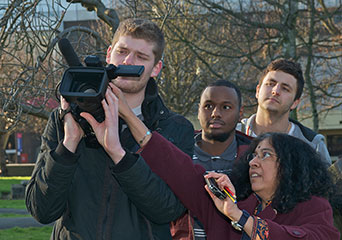Other aspects of work with young people
Informal education is central to work with young people, then, but it is not the only important feature. Other aspects of the work – such as social contact among young people and between young people and adults, and recreation and enjoyment – are surely worthwhile and valuable in themselves quite apart from any educational benefits that young people may derive from them.
There is one more important element that we would add to this. According to a youth policy document from the European Commission, work with young people also has a political dimension.
Youth work has an impact on young people’s life and helps them to reach their full potential. It contributes to their personal development, but also facilitates social and educational development. It enables them to develop their voice, influence and place in society.
In the following activity, we introduce two case studies and use them to apply the ideas that we have been examining.
Activity 4: Applying ideas to practice
We can summarise the main features of work with young people as four ideas (European Commission, 2012; Verschelden et al., 2009):
- informal education – personal development and learning from the everyday
- social contact with other young people and the wider society
- recreation and enjoyment
- development of voice and influence.
Read through the two case studies below and look for examples within each of the four ideas summarised above. Try to explain briefly how each point is illustrated within each case study example.
As you will see, the case studies are written in rather different styles – the first is more ‘academic’, the second is more ‘journalistic’. This reflects their origins in an academic publication and a broadsheet newspaper respectively.
Note that both examples include children and young people of different ages. However, both describe work with young people within a particular community – one in a hospital and the other in a large city.
Please make a note of your answers in the box below.
Case Study 1 – Hospital youth work
Research undertaken in a city hospital showed that many young people arrived at Accident and Emergency with symptoms of self-harm or overdose but, after the admissions procedure, did not wait to be treated. This was seen as a ‘cry for help’ which was going unheard. Feedback from young people was that they were being treated as ‘cases’ rather than as individuals. The report argued for a young person’s advocate to provide them with information and support during clinical encounters so that they were able to take responsibility for their health. Discussion led to the recognition that the hospital was too heavily focussed on medical intervention, failing to take account of the other issues in young people’s lives: their family situation, housing, emotional stability – and therefore, their ability or readiness to engage with medical professionals.
Three youth workers now form the Hospital Youth Work Team and, after initial cynicism about what was an untried approach, this has now become an integral part of the hospital’s service to young people. All young patients aged 11 upwards are contacted by youth workers. They offer support, information and activities, including taking young people out for a break, to the shops, or for a game of pool. Frequently they are involved intensively with young people who are distressed and fearful. Alongside such casework support, a central concern is to be advocates on behalf of young people, to ‘de-mystify’ medical language so that they can understand and be more actively involved in their own health care. The team runs training sessions with medical staff about communicating with young people, and about young people’s issues and perspectives.
Youth workers have made a significant difference within the hospital:
I can see the transition of the young people. They are healthier; they are taking responsibility for themselves; they are empowered; they are able to vocalise their views; elements of contentment/satisfaction in their lives – you can see that in the way they engage with professionals (Member of Hospital Staff).
Case Study 2 – Youth clubs: from boxercise to building
It’s 4:45pm and the Hunslet Club in south Leeds is so busy that I have to queue for quite some time to get in. Toddlers are racing around, parents drink coffee and kids in, variously, ballet outfits, gym kits and disco gear jostle to get past me.
It’s a typical Tuesday evening at the club, which has been running since 1940 in various guises, though never quite as actively as this. As enthusiastic chief executive Dennis Robbins, who has been with the club since 1970 when he was [a] 10-year-old, explains, ‘we now have a membership of 2,200, up from 200 when I joined’. …
The Hunslet Club is just one member of youth club charity Ambition, which has just changed its name from Clubs For Young People in a rebrand and refocus. Helen Marshall, Ambition’s chief executive, says the rebrand was important to raise the profile of clubs such as Hunslet: ‘The youth sector is a crowded sector but we are the UK’s leading youth club charity and we need to better advocate on behalf of our members.’
It’s doing this with a new three-year strategic plan … It’s also, thanks to a recent conference, Say Something, in which its young members helped shape the three-year plan, suggesting more business enterprise schemes, something the organisation now plans to promote.
In the case of Hunslet it’s not hard to see why the trumpet doesn’t get blown often. There’s simply no time. The energetic Robbins is far too busy teaching boxercise, ruffling small people’s hair and joining in with a hip-hop dance class to worry about proving the club’s worth. Nonetheless, its worth is evident. There’s an eye-watering timetable of clubs and classes, ranging from toddler ballet to City & Guilds courses in construction.
Serving the whole of south Leeds, the club is funded by Education Leeds to train local Neets (those not in education, employment, or training) and it works with 220 referred kids across the region. However, at the other end of the scale some of the provision is so good that kids travel from as far as York to use its boxing facilities. …
Clubs at Hunslet cost just £1.50 a pop, hardly a route to riches. So the facilities, 40 staff members and training are funded in an ingenious way. On weekends, the club doubles as a fully-licenced wedding venue and it also hires rooms out to private clubs through a private company, Hunslet Leisure Limited, which then gifts the profits back to the club.
Ambition works with clubs like Hunslet to provide training and support as well as funding (which in turn comes from business funding, charitable donations and smaller private donations). And the work it does is vital, says Marshall.
‘As much as 40% of voluntary youth clubs are in the most deprived areas of the UK,’ she says. ‘Attendance is voluntary and there’s a much more different dynamic than that in formal education. However, the relationship between a youth club and a school means that they can help each other.’
Discussion
Here are some of our thoughts about the two case studies.
Case Study 1 – Hospital youth work
Informal education – personal development and learning from the everyday
This takes place where the young person and the youth worker engage together in everyday learning related to the young person’s sense of well-being. Understanding what is happening to them now and what may happen in the future is of the utmost significance for the young person. The setting contributes to personal, social and emotional development as it helps young people come to terms with a difficult time in their life.
Social contact with other young people and the wider society
We can see that the presence of the youth workers gives opportunity for social contact and activity, and develops confidence in the young people – an attribute that will help them to form relationships and associate with others now and in the future. Young people will have a shared project of, sadly, being unwell in a strange institution and possibly hoping to ‘get better’. With support of the youth workers there may be opportunities to be ‘young together’ with other young people.
Recreation and enjoyment
This setting offers opportunities for recreational activities such as shopping and pool.
Development of voice and influence
The demystification of medical language helps the young people to understand and be more actively involved in their own medical care. There is evidence that they are able to express their views more readily.
Case Study 2 – Youth clubs: from boxercise to building
Informal education – personal development and learning from the everyday
It is difficult to be specific but it would seem that young people are encouraged to feel part of something bigger in this setting. Their needs and interests are being taken seriously as they are involved in planning, as well as taking part in activities and developing relationships with adults. This will help them to develop confidence and belief in themselves.
There are also opportunities for more formal learning where appropriate, sometimes in association with schools. The young people who are NEET (Not in Education, Employment or Training) attend the centre for training, and City and Guilds courses in construction are on offer. This is another example of informal and formal learning taking place alongside each other.
Social contact with other young people and the wider society
There seem to be plenty of opportunities in this setting for young people to meet others and for them to feel part of their local or wider community.
Recreation and enjoyment
Plenty of recreational examples are cited in the case study, with emphasis on boxing and different kinds of dance.
Development of voice and influence
Young people were involved in preparing the business plan for the club and suggested more enterprise activities. This gives them an opportunity to have a say in how the club runs.
In this section we have considered similarities between settings with young people to help us recognise these when we encounter them. In the next section we will look at some further ideas that will help us to consider the differences and contrasts between practice settings.

